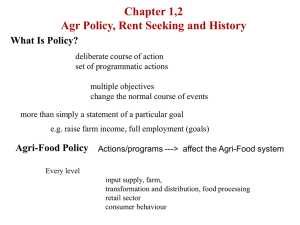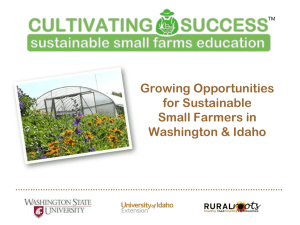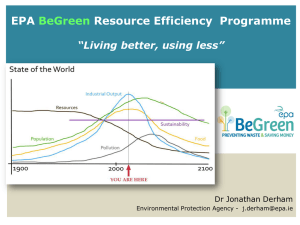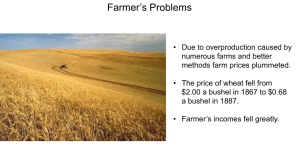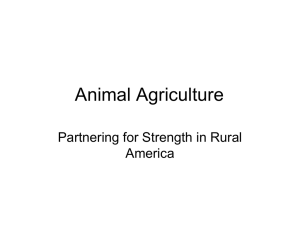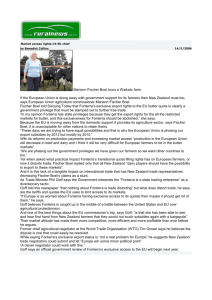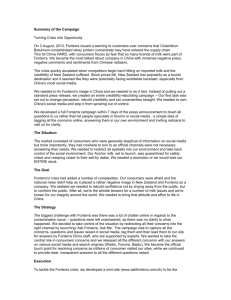Fonterra Case Study (DOC)
advertisement
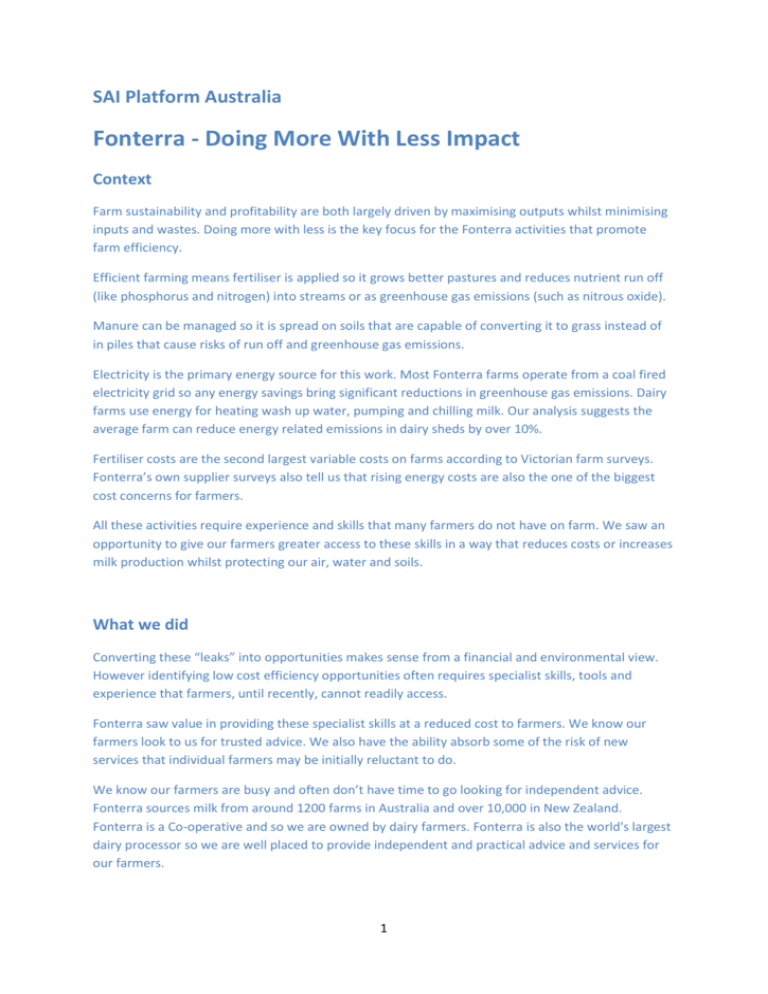
SAI Platform Australia Fonterra - Doing More With Less Impact Context Farm sustainability and profitability are both largely driven by maximising outputs whilst minimising inputs and wastes. Doing more with less is the key focus for the Fonterra activities that promote farm efficiency. Efficient farming means fertiliser is applied so it grows better pastures and reduces nutrient run off (like phosphorus and nitrogen) into streams or as greenhouse gas emissions (such as nitrous oxide). Manure can be managed so it is spread on soils that are capable of converting it to grass instead of in piles that cause risks of run off and greenhouse gas emissions. Electricity is the primary energy source for this work. Most Fonterra farms operate from a coal fired electricity grid so any energy savings bring significant reductions in greenhouse gas emissions. Dairy farms use energy for heating wash up water, pumping and chilling milk. Our analysis suggests the average farm can reduce energy related emissions in dairy sheds by over 10%. Fertiliser costs are the second largest variable costs on farms according to Victorian farm surveys. Fonterra’s own supplier surveys also tell us that rising energy costs are also the one of the biggest cost concerns for farmers. All these activities require experience and skills that many farmers do not have on farm. We saw an opportunity to give our farmers greater access to these skills in a way that reduces costs or increases milk production whilst protecting our air, water and soils. What we did Converting these “leaks” into opportunities makes sense from a financial and environmental view. However identifying low cost efficiency opportunities often requires specialist skills, tools and experience that farmers, until recently, cannot readily access. Fonterra saw value in providing these specialist skills at a reduced cost to farmers. We know our farmers look to us for trusted advice. We also have the ability absorb some of the risk of new services that individual farmers may be initially reluctant to do. We know our farmers are busy and often don’t have time to go looking for independent advice. Fonterra sources milk from around 1200 farms in Australia and over 10,000 in New Zealand. Fonterra is a Co-operative and so we are owned by dairy farmers. Fonterra is also the world's largest dairy processor so we are well placed to provide independent and practical advice and services for our farmers. 1 Our solution includes targeted marketing to farmers. We think they will open our mail, not just because we send them money. An expression of interest process then follows with screening to identify eligible farms. Farmers with non-compliance on any environmental requirement are not eligible. Following this the appointed energy or nutrient planning specialists undertakes an on-site visit to identify the “leaks” and find viable solutions that are customised for each farm. For example fertiliser application needs to be based on soil capacity and this often requires precise mapping of farm soil types and nutrient budgets based on the needs of each soil type. Energy savings can often be found by closer monitoring of the input and output temperatures of milk chilling gear, better matching pump speeds to milking loads or adjustment of hot water thermostats. Many of our farmers had already got some fundamentals right and so we encouraged them to undertake more innovative projects. These innovations mainly included a wider distribution of effluent on land that was not irrigated. This reduces fertiliser demand and allows effluent to be spread on pastures where and when it needed most. Other solutions included automation of irrigation shut offs and water reuse systems. Outcomes Currently 140 farm projects have been completed and 80 have commenced and are currently in progress. A small number (15) of project spots are resourced but yet to be finally allocated to eligible farms. In the initial stages of the program it was funded solely by Fonterra investment. Following the success of this initial phase the program is now resourced to cover a total of 235 farm projects on at least 200 separate farms. Once these are completed then about 20% of the entire Fonterra farm base in Australia will have undertaken some of form of “doing more with less” project. On average our fertiliser and nutrient efficiency projects will provide a 15% reduction in fertiliser related emissions on each farm. There will also be a reduced risk of reduced water quality in surrounding waterways. Meanwhile the average energy efficiency project will provide a 10% reduction of electricity related emissions. Once the projects are completed the average financial gain is estimated to be $AUD 8,000 per farm for fertiliser and nutrient efficiency projects and $AUD 2,000 per farm for energy related projects. Farmers can essentially choose to take this dividend as increased production or reduced costs, or a mix of both. Our program data also suggests that effluent is now able to be applied to an additional 728 ha which Apart from the results described above Fonterra has also demonstrated our effective farmer relationships and project delivery mechanism. Our “back office” includes a farmer EOI process, initial eligibility screening, on site consultation, a simple approval and contracting process for standard projects and a farmer “peer-review” forum for 2 the more innovative ideas from our farmers. This allows better return on investments and reduced project risk for Fonterra as an investor and for farmers. Our approach demonstrates we can get high levels of farmer engagement and practice change by leveraging the existing supplier and processor relationships rather than other delivery models. Consequently the Australian Government and the NRM North catchment authority have taken an interest in our approach and have also invested enabling it to expand to even more farmers. Linking public and private sector investment and delivery shows considerable promise for more sustainable and profitable farming systems. Each farm project generates a positive return on investment for an average farm. For every dollar invested in farm energy use assessments an average of $2.20 of savings was identified. Savings opportunities were identified at over 90% of farms. These saving are from low cost operational modifications that don’t require large capital expenses. Fertiliser efficiency projects returned at least $1.50 in annual payback to the farmer for each dollar invested by Fonterra or by governments agencies. Additionally all of the fertiliser efficiency projects required at least matching 1:1 investment from farmers to make projects even more effective. A focus on more efficient practices has clear financial benefits for all parties. 3 Graphic 4 5



